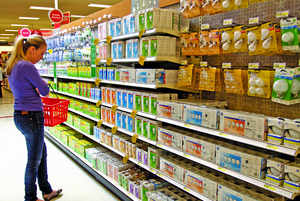MISSION, KS--(Marketwire - May 31, 2012) - (Family Features) The way you light your home is changing, starting with how you shop for light bulbs. In addition to new choices in technology -- state of the art LEDs or CFLs, for example -- you have a variety of options in terms of brightness, as well as how long you want the bulb to last. In addition, you have the option of spending more money up front on an energy efficient bulb that can save you money in the long-run.
The good news is you don't have to be an Edison to find the right bulb. Use these tips and resources to pick the perfect bulb for your home:
Calculate Your Savings
Before you hit the stores, do your homework. Determine what lighting attributes are important to you, whether it's long life, instant-on, dimming capabilities, bulb shape or luminosity. Different bulb technologies offer different benefits. To boil down how much switching to a more efficient bulb means for you, look for resources like the savings calculator GE offers at www.gelighting.com/lighttransforms. It shows consumers how much they'll save with a simple switch from incandescent bulbs to GE's Energy-Efficient Soft White bulbs, which operate much like incandescent bulbs but are up to 28 percent more efficient.
Check the Facts
The back of every new light bulb package now includes a "Lighting Facts" label that is similar in form to the nutrition label on the back of food boxes. The Lighting Facts label provides information about lumens (brightness), energy cost, life expectancy, light appearance (warm versus cool light), wattage and mercury content. Mandated by the Federal Trade Commission (FTC), the label is meant to standardize how companies in the lighting industry convey light bulb features, helping you to quickly make comparisons between bulbs and bulb technologies.
Look for Lumens, Not Watts
In addition to the Lighting Facts label, some light bulb packaging is placing more emphasis from classifications by watts instead classifications by lumens. While you may have equated watts with brightness every time you made a bulb purchase, in true lighting terms, this gauge isn't accurate. Watts are merely the measure of electrical energy used to light a bulb. A lumen is a measure of the bulb's brightness. Simply put, the higher the lumen number, the brighter the bulb. So, if you are looking for a brighter light, look for a higher lumen number on the box. The same isn't necessarily true for watts. In fact, a 13 watt CFL may be brighter than a 60 watt incandescent bulb.
Examine New Packaging
Along with the Lighting Facts label, some manufacturers are going one step further in helping consumers decipher differences in bulbs by changing their packaging. For example, GE Lighting has implemented a color-coding system to help you better understand the light that will be emitted from each bulb. Color selections are modeled after the natural cycle of daylight, from sunrise to sunset. For example, yellow boxes represent bulbs with strong, vibrant light ideal for home cooking, cleaning and grooming, while purple boxes represent subtle and reassuring light for use at night.
For more tips on finding the light bulb that's right for your needs, visit www.GELighting.com/lighttransforms.
About Family Features Editorial Syndicate
This and other food and lifestyle content can be found at www.editors.familyfeatures.com. Family Features is a leading provider of free food and lifestyle content for use in print and online publications. Register with no obligation to access a variety of formatted and unformatted features, accompanying photos, and automatically updating Web content solutions.
Contact Information:
Wendy MacDonald
wmacdonald@familyfeatures.com
1-888-824-3337 ext. 235
http://editors.familyfeatures.com
